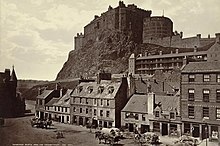Grassmarket
The Grassmarket is a historic market place, street and event space in the Old Town of Edinburgh, Scotland. In relation to the rest of the city it lies in a hollow, well below surrounding ground levels.
First mentioned in the Registrum Magni Sigilii Regum Scotorum (1363) as "the street called Newbygging [new buildings] under the castle", the Grassmarket was, from 1477, one of Edinburgh's main market places, a part of which was given over to the sale of horses and cattle (the name apparently deriving from livestock grazing in pens beyond its western end).[1]
 Western end of Grassmarket, painted in 1845
Western end of Grassmarket, painted in 1845Daniel Defoe, who was sent to Edinburgh as an English government agent in 1706, reported the place being used for two open air markets: the "Grass-market" and the "Horse-market". Of the West Bow at the north-east corner, considerably altered in the Victorian period, he wrote, "This street, which is called the Bow, is generally full of wholesale traders, and those very considerable dealers in iron, pitch, tar, oil, hemp, flax, linseed, painters' colours, dyers, drugs and woods, and such like heavy goods, and supplies country shopkeepers, as our wholesale dealers in England do. And here I may say, is a visible face of trade; most of them have also warehouses in Leith, where they lay up the heavier goods, and bring them hither, or sell them by patterns and samples, as they have occasion."[2]
 Edinburgh Castle from the Grassmarket, photographed by George Washington Wilson in c. 1875
Edinburgh Castle from the Grassmarket, photographed by George Washington Wilson in c. 1875From 1800 onwards the area became a focal point for the influx of Irish immigrants and a high number of lodging houses appeared for those unable to pay a regular rent. Community views of these immigrants were polarised by the Burke and Hare murders on Tanners Close at West Port (the west end of the Grassmarket) in 1828. From the 1840s conditions were somewhat horrendous, with up to 12 people in what would now be deemed a small double bedroom, and occupants being locked in the room overnight. Police inspections had begun in 1822 but the rules themselves caused many of the problems. A further Act of 1848 combined police surveillance with limits on occupation. In 1888 the City Public Health Department recorded seven lodging houses holding a total of an incredible 414 persons. Crombies Land at the foot of West Port held 70 people in 27 bedrooms, with no toilet provision.[3]
As a gathering point for market traders and cattle drovers, the Grassmarket was traditionally a place of taverns, hostelries and temporary lodgings, a fact still reflected in the use of some of the surrounding buildings. In the late 18th century the fly coach to London, via Dumfries and Carlisle, set out from an inn at the Cowgate Head at the eastern end of the market place.[4] In 1803 William and Dorothy Wordsworth took rooms at the White Hart Inn, where the poet Robert Burns had stayed during his last visit to Edinburgh in 1791. In her account of the visit Dorothy described it as "not noisy, and tolerably cheap".[5] In his 1961 film Greyfriars Bobby Walt Disney chose a lodging in the Grassmarket as the place where the Skye terrier's owner dies (depicting him as a shepherd hoping to be hired at the market rather than the real-life dog's owner, police night watchman John Gray).
The meat market closed in 1911 when a new municipal slaughter house at Tollcross replaced the old "shambles" in the western half of the Grassmarket (a road beyond the open market place) which joins King's Stables Road.
The association of the area with the poor and homeless only began to lessen in the 1980s: with Salvation Army hostels at both ends of the Grassmarket. Closure of the female hostel at the junction of West Port and the Grassmarket around 2000 in combination with an overall gentrification, capitalising on the street's location, began to truly change the atmosphere. Closure of the public toilets at the east end (a focal point for "jakeys" - drunken-down-and-outs) and comprehensive re-landscaping in the beginning of the 21st century has transformed the character of the area.
An inscribed flagstone in the central pavement in front of the White Hart Inn indicates the spot where a bomb exploded during a Zeppelin raid on the city on the night of 2–3 April 1916. Eleven people were killed in the raid, though none at this particular spot.[6]





































Add new comment